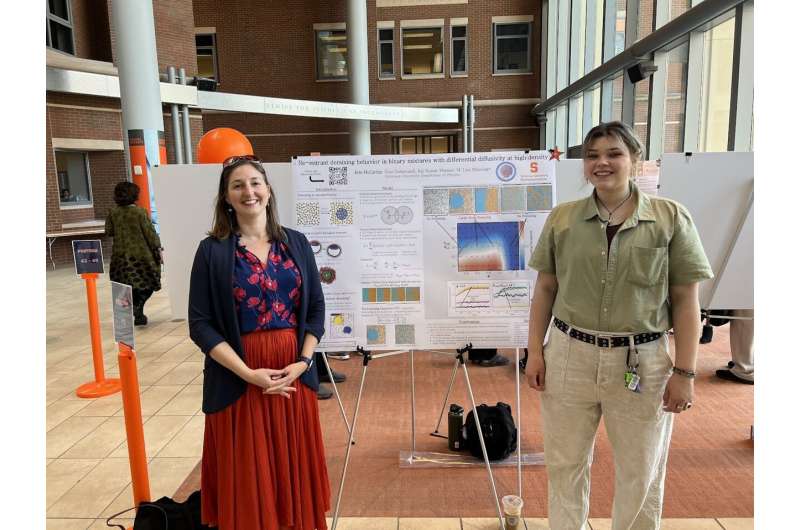This article has been reviewed according to Science X's editorial process and policies. Editors have highlighted the following attributes while ensuring the content's credibility:
fact-checked
peer-reviewed publication
trusted source
proofread
Using physics principles to understand how cells self-sort in development

Erin McCarthy '23, physics summa cum laude, is a rarity among young scientists. As an undergraduate researcher in Syracuse University's College of Arts & Sciences' Department of Physics, she guided a study that appeared in March 2024 in Physical Review Letters. It is the most-cited physics letters journal and the eighth-most cited journal in science overall.
McCarthy and postdoctoral associates Raj Kumar Manna and Ojan Damavandi developed a model that identified an unexpected collective behavior among computational particles with implications for future basic medical research and bioengineering.
"It's very difficult to get a paper into Physical Review Letters," said M. Lisa Manning, co-author, and the William R. Kenan, Jr. Professor of Physics as well as founding director of the BioInspired Institute at Syracuse University. "Your scientific peers must judge it as exceptional."
McCarthy, a New Jersey native, chose Syracuse because of its "tremendous energy," she said. "The educational and the research side of things was amazing. I came planning to be a physics major who was premed. I loved physics and biology, and I wanted to be involved in health care and medicine. And I got lucky in that I met Dr. Manning as a freshman, and she introduced me to computational biophysics. I started in research during my freshman year, which is extremely unusual."
"Erin learned coding from scratch, and then did hours and hours of simulations, which took a lot of perseverance," said Manning. "It's just a fantastic testament to her work ethic and brilliance that this paper appeared in such a prestigious journal."
The research team used computational physics modeling to figure out the underlying mechanisms that cause particles to sort spontaneously into different groups.
Learning how particles behave in physics models could provide insight into how living biological particles—cells, proteins and enzymes—remix themselves in development.
In the early stages of an embryo, for example, cells start out in heterogeneous mixtures. Cells must self-sort into different compartments to form distinct homogenous tissues. This is one of the major collective cell behaviors at work during development of tissues and organs and organ regeneration.
"Cells need to be able to organize themselves properly, segregating themselves to do their jobs," said McCarthy. "We wanted to understand, if you remove chemistry and look strictly at physics, what are the mechanisms by which this reorganization can happen spontaneously?"
Previous physics investigations found that particles separate when some receive a jolt of higher temperature. As one population of particles becomes injected with energy at a small scale, it turns active—or "hot"—while the other population is left inactive, or "cold." This difference in heat causes a reorganization among the two populations. These models are simplified versions of biological systems, using temperature to approximate cellular energy and movement.
"Hot particles push the cold particles aside so they can take over a larger space," said co-author Manna. "But that only happens when a gap exists between particles."
Previous modeling identified self-sorting particle behavior at less-packed, intermediate densities.
But the Syracuse team found something surprising. After injecting energy into a population of high-density particles, the hot particles did not shove cold ones around. The hot particles lacked space to do so.
That is important because biological particles—proteins in cells and cells in tissue—typically live in tight, crowded spaces.
"Your skin, for instance, is a very dense environment," said McCarthy. "Cells are packed so closely together, there's no space between them. If we want to apply these physics findings to biology, we must look at high densities for our models to be applicable. But at very high densities, the difference in activity between two populations does not cause them to sort."
There must be some other self-sorting mechanism at play in biology. "Temperature or active injection of energy does not always separate things, so you can't use it in biology," said Manning. "You must search for some other mechanism."
To Manning, this study illustrates the strengths of Syracuse University. "The fact that an undergraduate spearheaded this research speaks to the awesome quality of students we have at Syracuse University, who are as good as those anywhere in the world, and to the exceptionalness of Erin herself," said Manning.
Manna, the postdoctoral mentor for the last part of McCarthy's project, was essential in driving it to conclusion. "The study wouldn't have happened without him," said Manning. "This demonstrates that we are able to recruit outstanding postdoctoral associates to Syracuse because we are such a great research university." Manna is now a postdoctoral fellow in the Department of Physics at Northeastern University.
McCarthy, a research technologist in a biological lab at the Northwestern University School of Medicine, plans to start applying for graduate school.
"At Syracuse," said McCarthy, "I learned how much I love research and want it to be a part of my future."
More information: Erin McCarthy et al, Demixing in Binary Mixtures with Differential Diffusivity at High Density, Physical Review Letters (2024). DOI: 10.1103/PhysRevLett.132.098301
Journal information: Physical Review Letters
Provided by Syracuse University





















